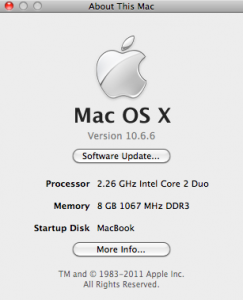*** Please read your EULA carefully prior to completing this installation. Note that I have not made use of any hacks or tools and have used only my Apple recovery DVD. OS X Server is allowed to be virtualized under certain conditions on Apple-branded hardware, and I am running an Apple machine. My intent is not to cheat Apple, as I have already purchased their hardware and, presumably, their software. ***
My main system is a MacBook 6,1 (late-2009) model on which I normally run Ubuntu. However, I have been trying to find a way to run OS X under emulation (to avoid bootloader issues and to simply have it ready all the time). After researching for quite some time, I decided that it might be worth a shot to simply try running the restore discs that came with the machine under VirtualBox.
First, I downloaded VirtualBox 4.0.4 from Oracle (http://virtualbox.org), 64-bit version for Ubuntu 10.10. The version that is available through the repositories is missing some functionality as it is the open source version. I also downloaded the extension pack so that full USB capabilities would be available.
After installing VBox, I went ahead and setup a new virtual machine, selecting OS X Server 64-bit as the machine type, memory set to 2048 MB, and graphics memory set to 128 M (with 3D acceleration enabled). I also changed the networking to Bridged mode as this tends to work better for my purposes.
When first running the machine, insert the first disc that came with the machine and configure VBox to use that disc. You’ll see a lot of console information go by before the installation screens finally start. Once you’re in the GUI and at the point where you would normally select the drive to install to, there won’t be a drive available. Click on the Utilities menu and Disk Tools. With the correct drive selected, click the Partition tab and replace Current with 1 Partition. Make sure the partition is configured as HFS+ Journaled and then click the Partition button. Once complete, close the Disk Tool window. Your drive should now be visible as an option for installation.
Make sure you click Customize and select any additional software prior to continuing. Then click Install and find a few web sites to surf (http://www.s100computers.com).
Amazingly, everything except video seems to work properly straight out of the box. The video works fine, I just haven’t found a way to change the resolution to 800×600 (at 1024×768, the default, it overflows the screen and I have to scroll). Sound seems to work, although it’s not great quality sometimes. The system is responsive and I haven’t encountered any problems thus far.
I’ll be installing all my normal Mac software over the next few days and will try to remember to post updates.
This marks the point of having Ubuntu 10.10 64-bit as my main O/S, with Windows 7 64-bit and Mac OS X 64-bit both available any time I need them. I recommend the 8 GB upgrade mentioned elsewhere, however, as 2 virtual machines will quickly eat up your available RAM if you want to have any kind of performance.
For those wondering, I enjoy the look and feel of Linux on a day to day basis better than Mac OS X and Windows. All 3 operating systems have their good and bad points and it’s really just a matter of personal choice. My main reason for purchasing the MacBook was to get a well-integrated platform to install Linux on, even if that turned out to be a pain in the derrier.
